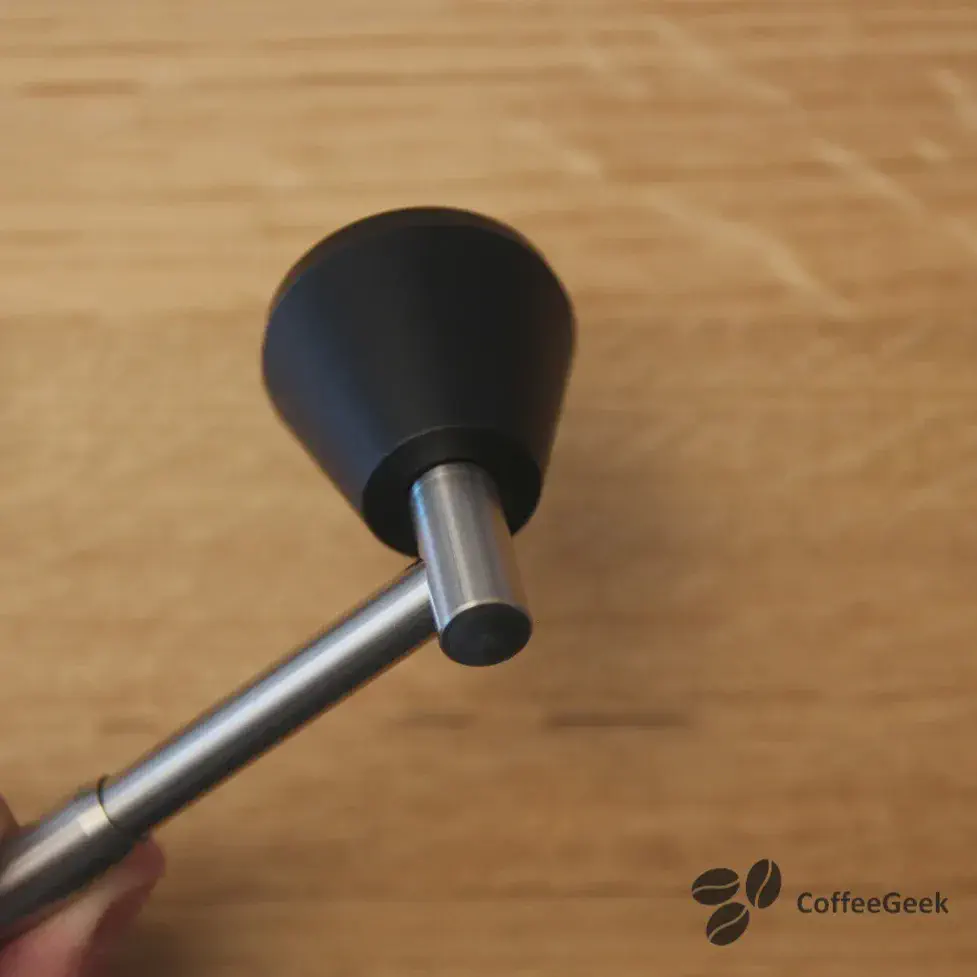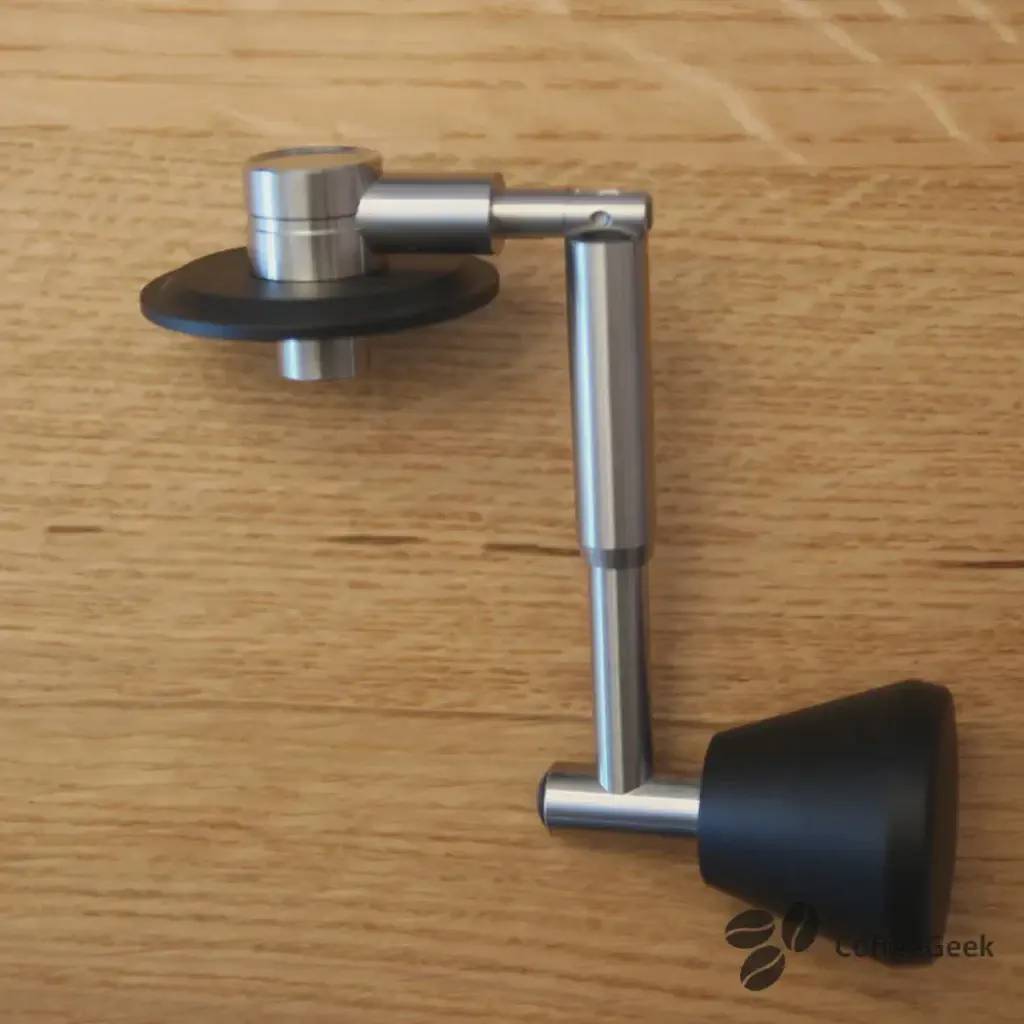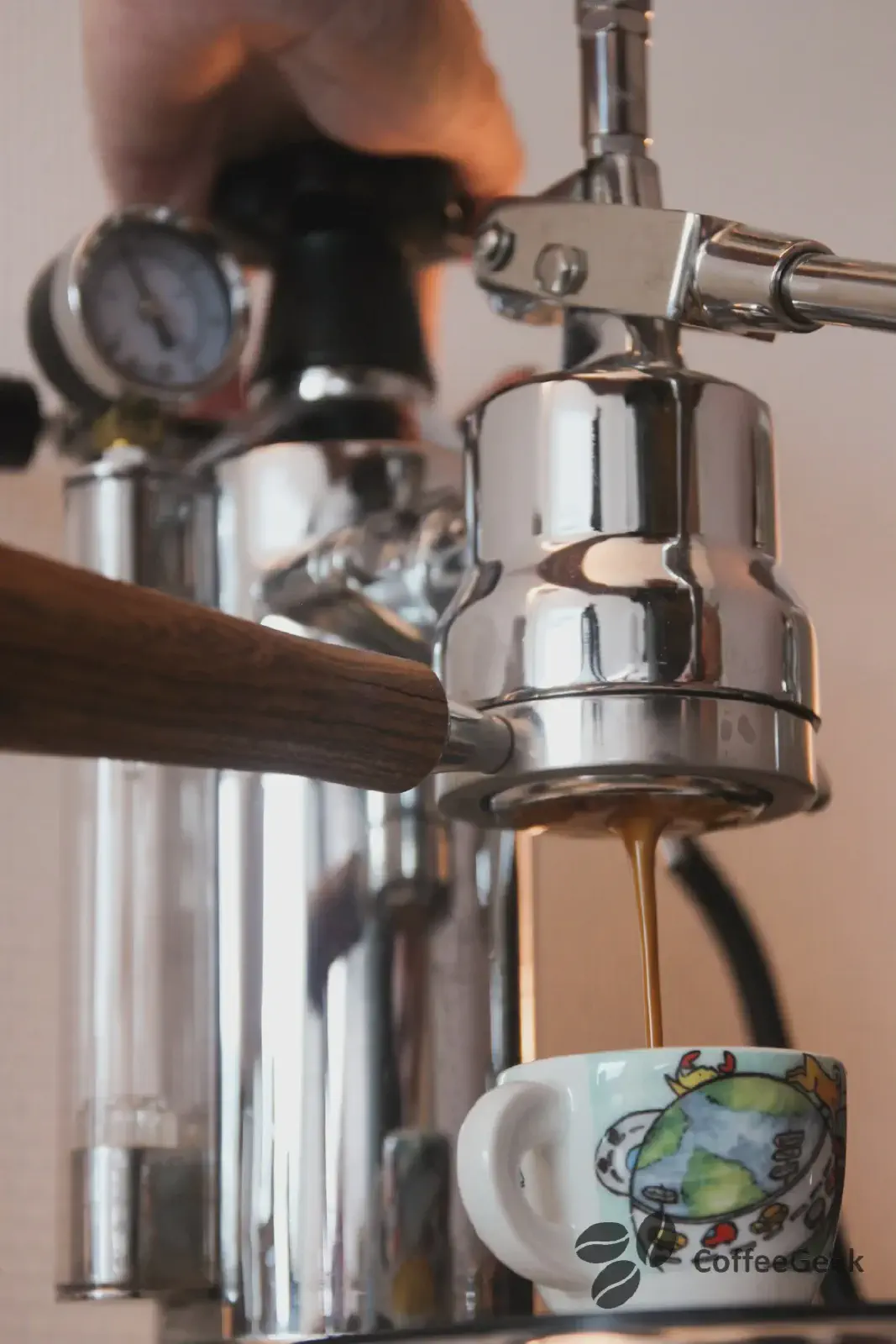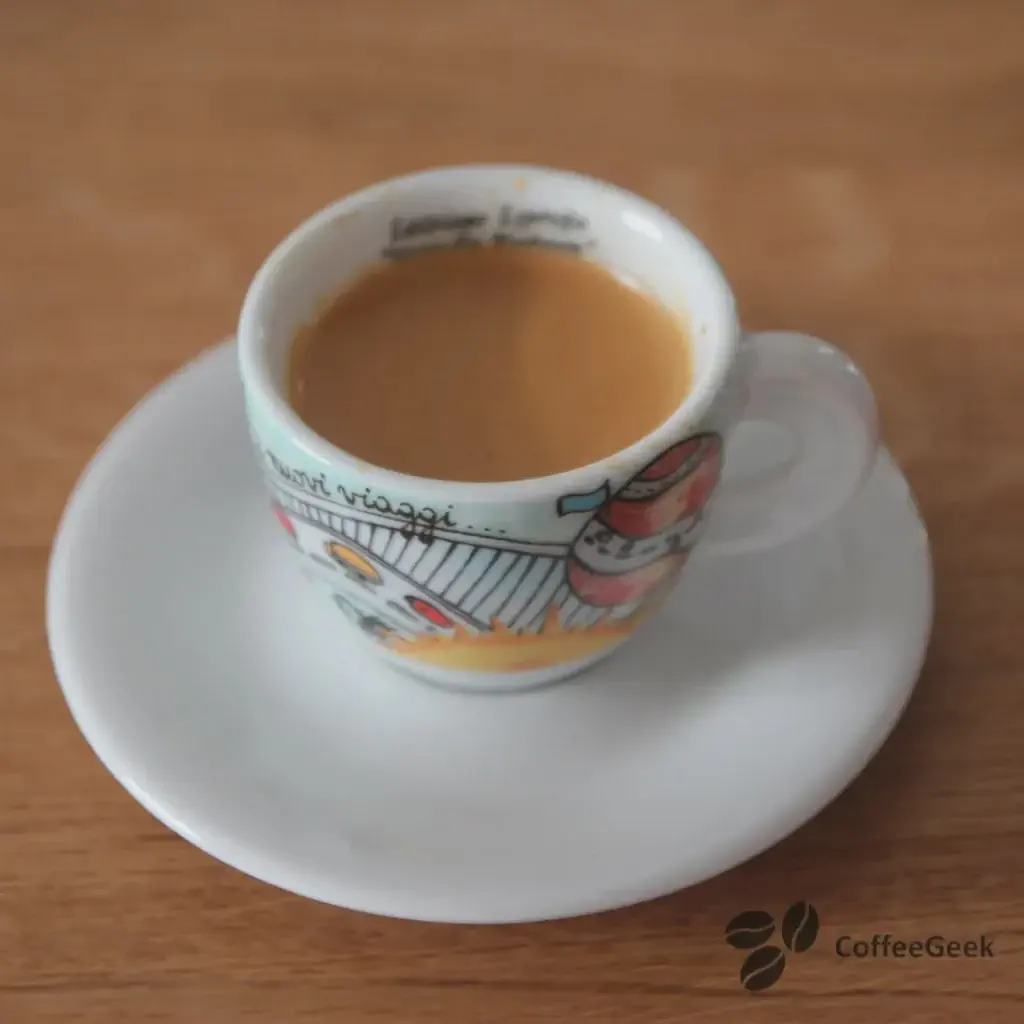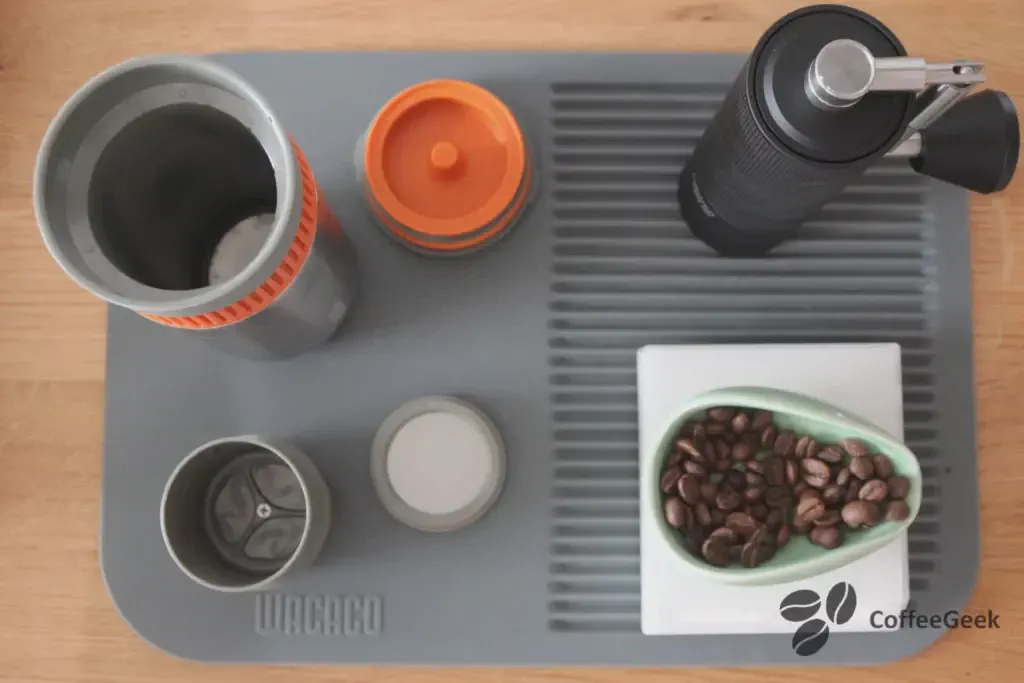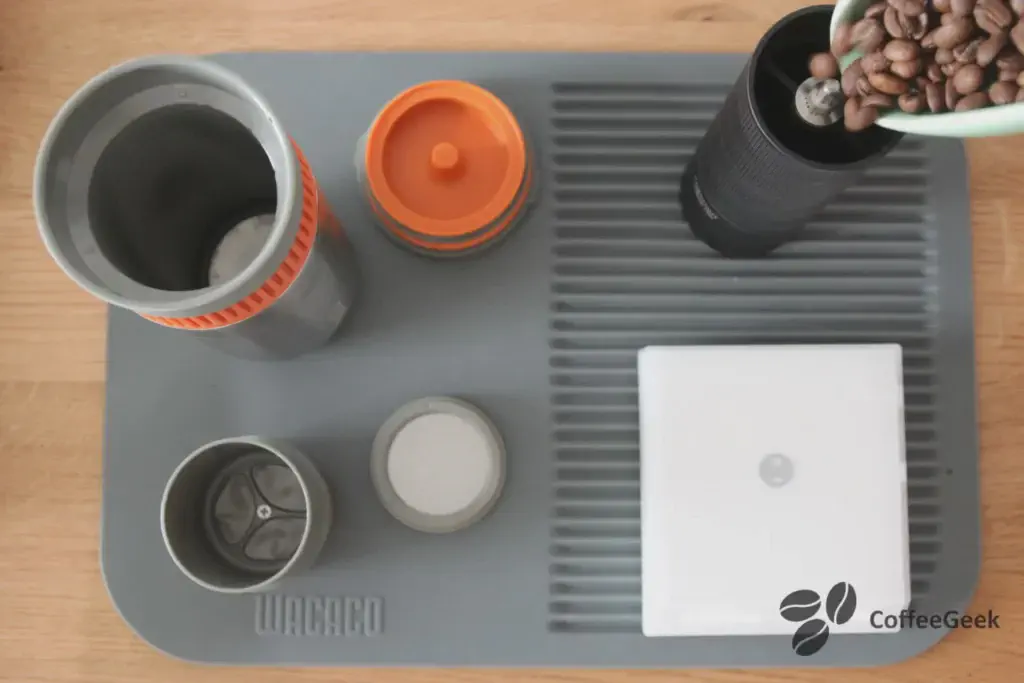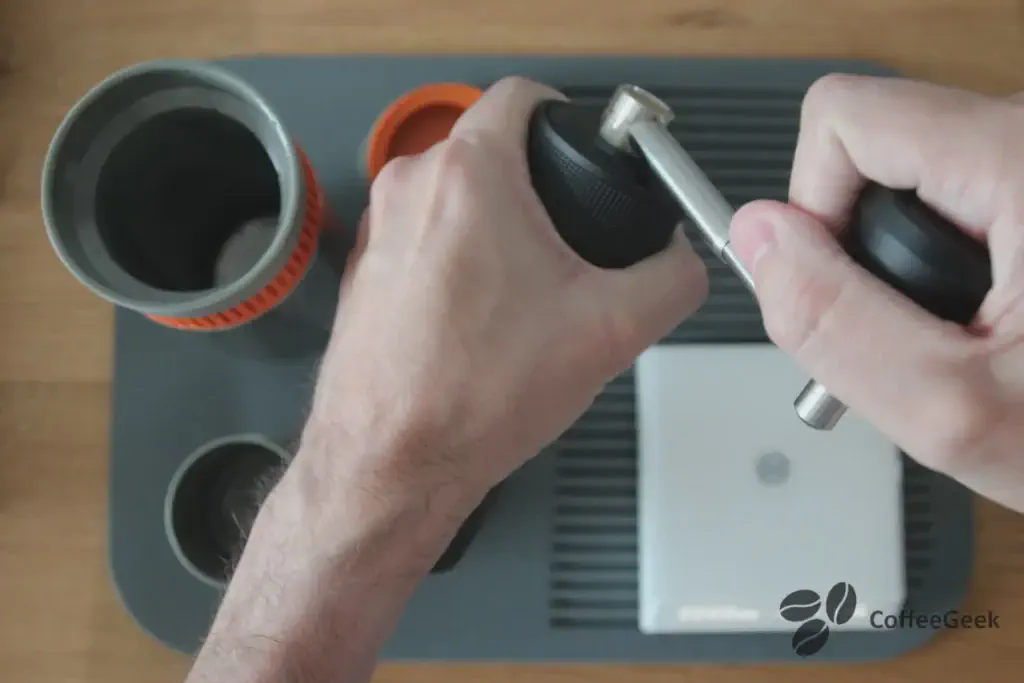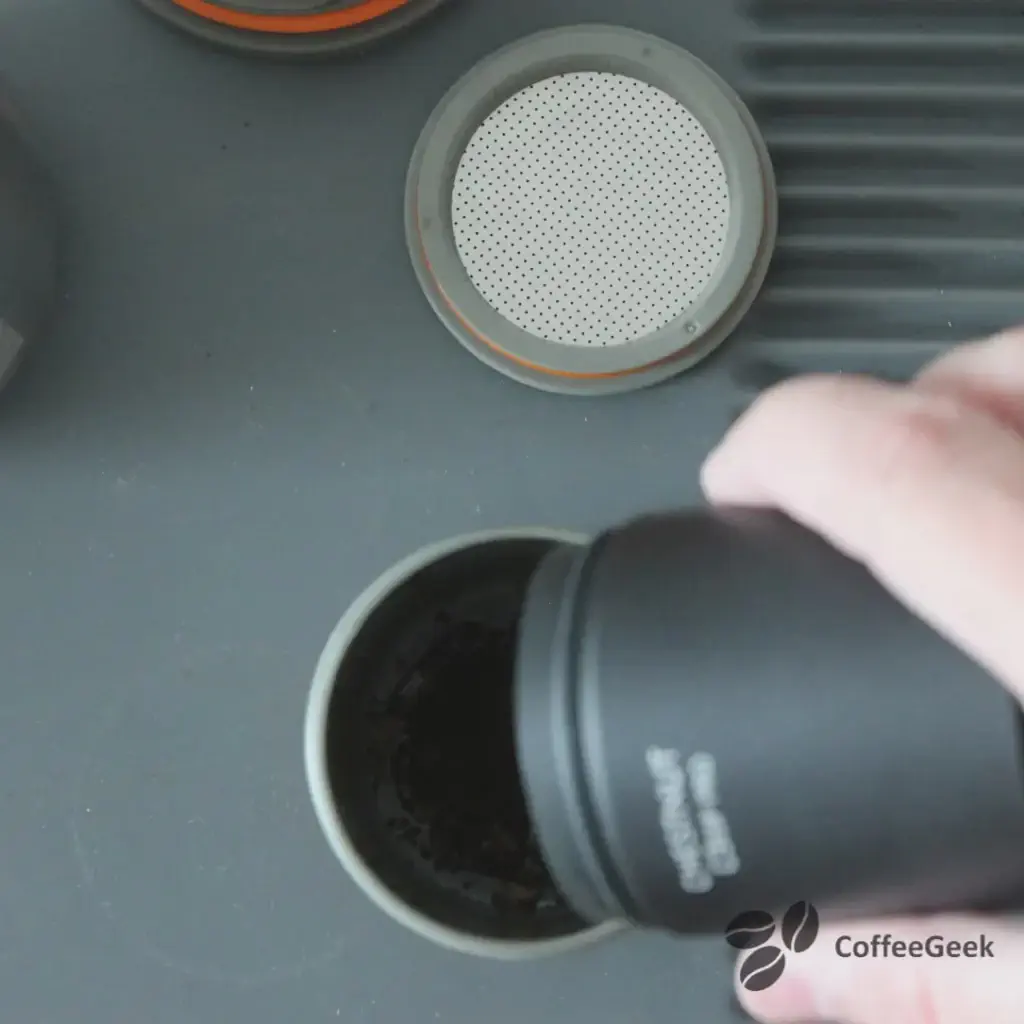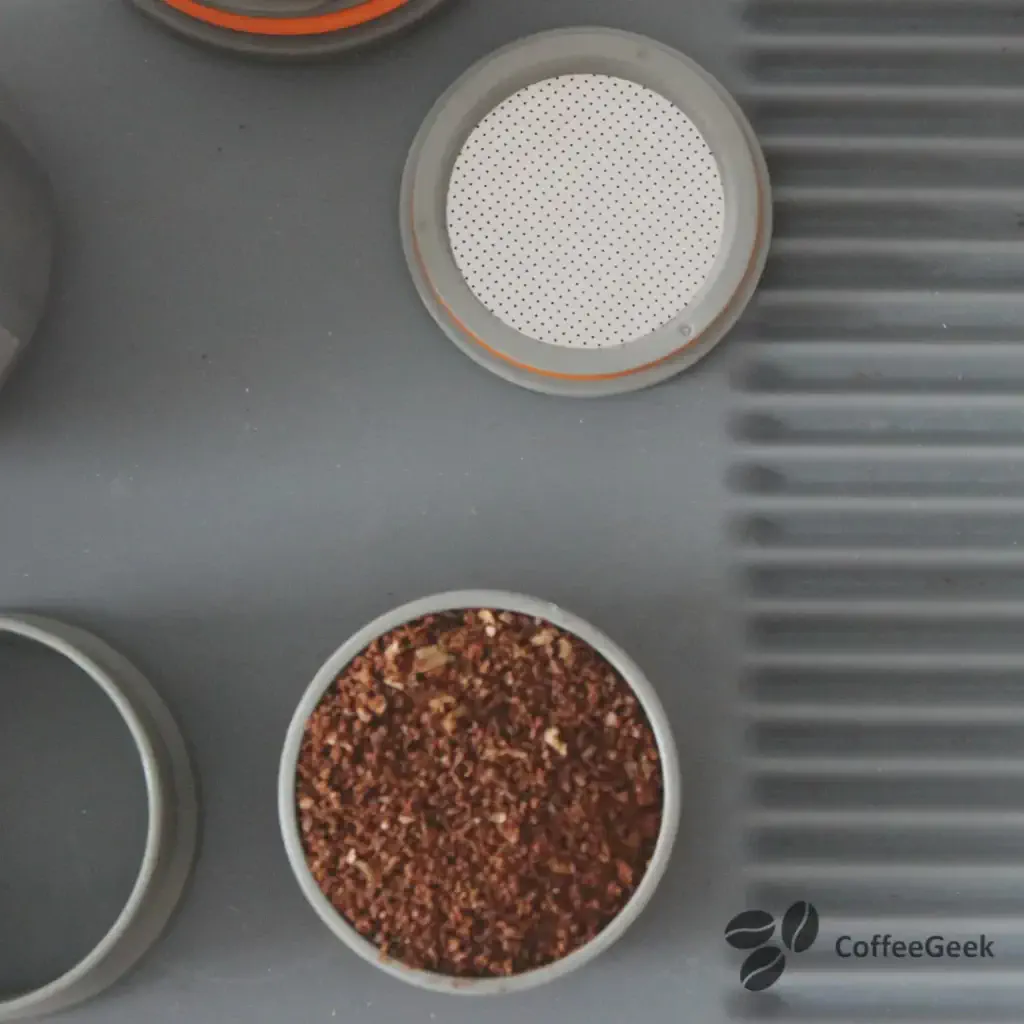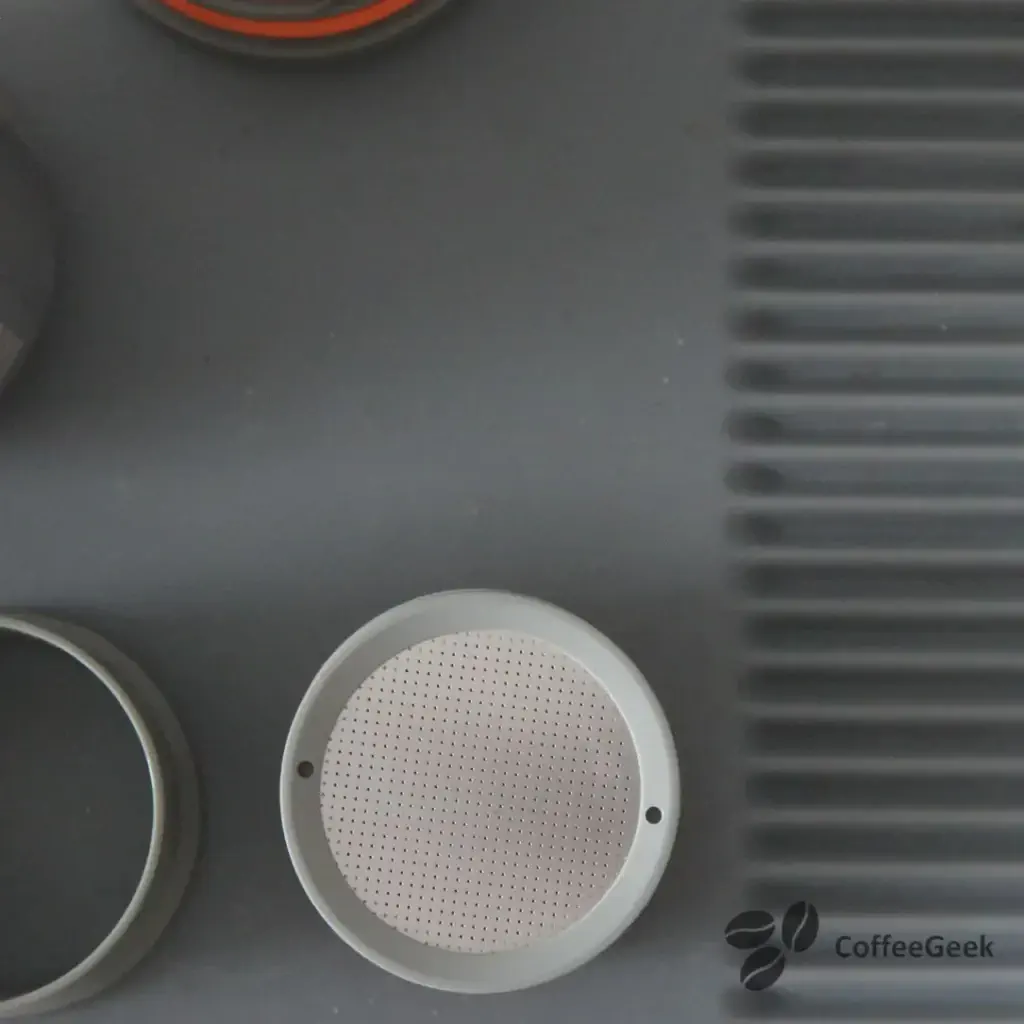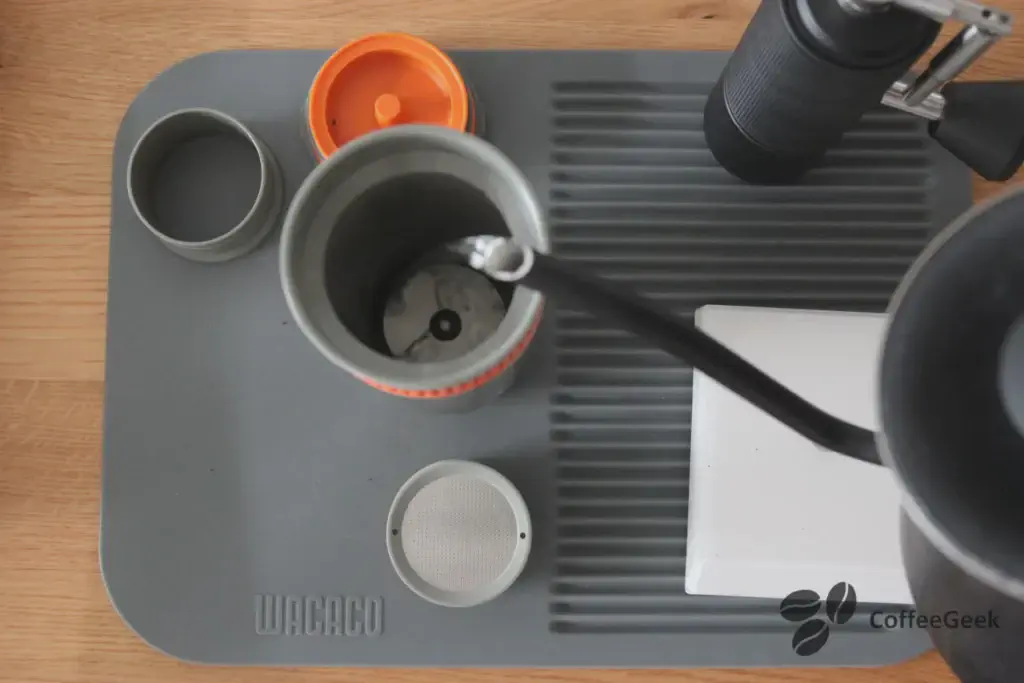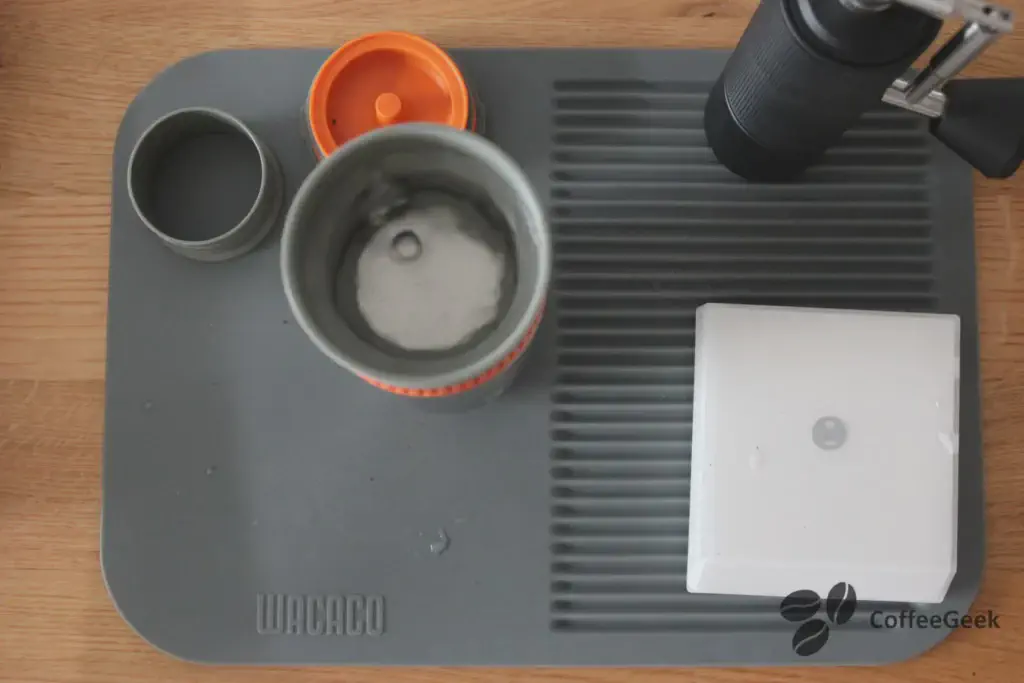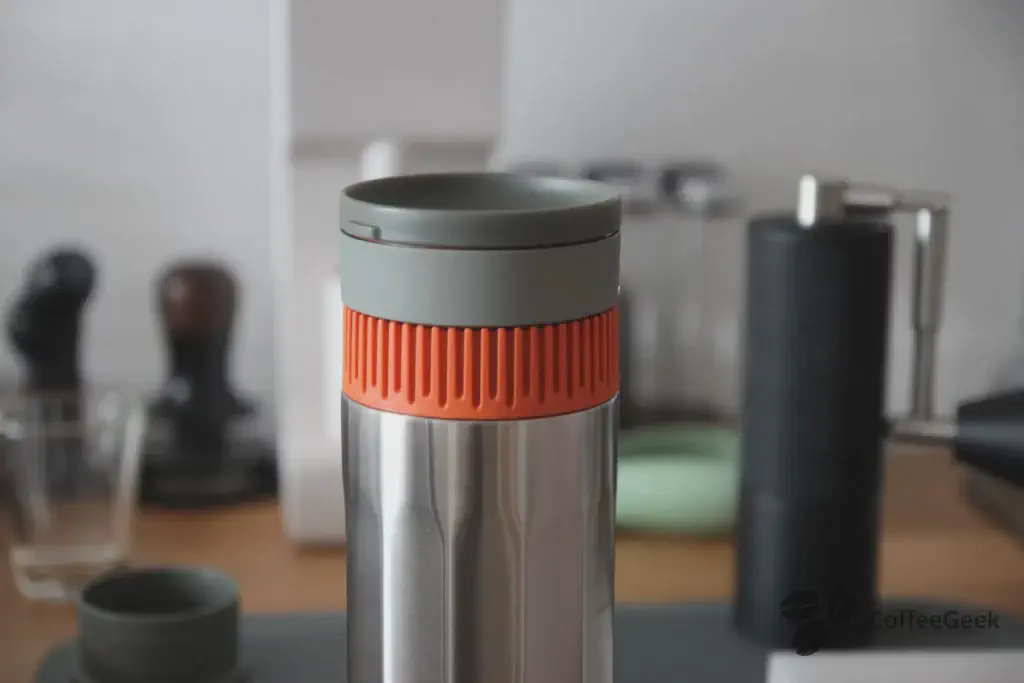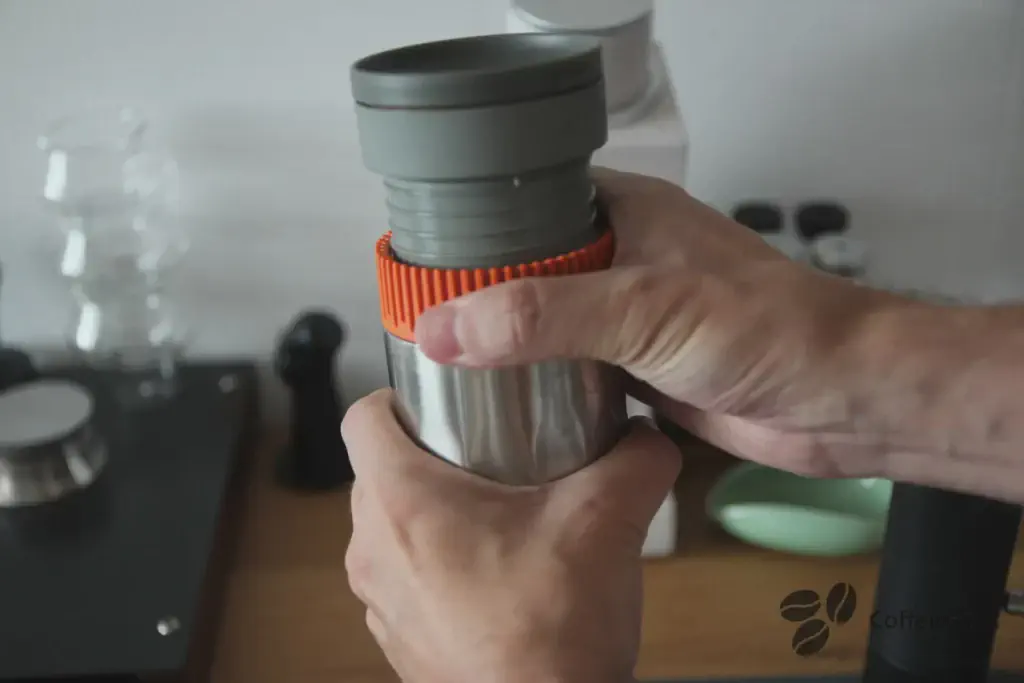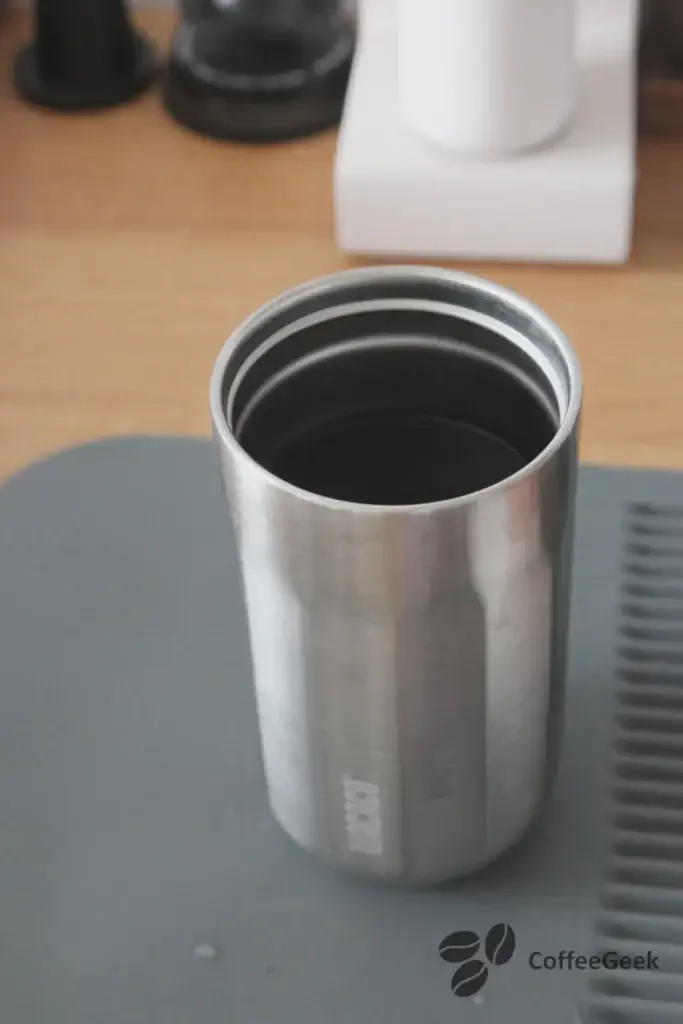Timemore C3 ESP Pro Travel Coffee Grinder Review

Discover the Timemore C3 ESP Pro coffee grinder, a must-have for coffee lovers on the go. Thanks to its innovative folding crank and compact design, this tool is perfect for travel. In this article, I share my experience along with an objective evaluation of its performance. Dive into its features and see why it could become your ally for enjoying excellent coffee, no matter where you are.
I recently invested in the Timemore C3 ESP Pro coffee grinder following my many business trips and my increasing use of travel coffee machines. Recommended by several very satisfied acquaintances, this grinder quickly intrigued me. This article is not sponsored by Timemore; I acquired it on my own, for personal use. My goal is to offer you a test that is as accurate and objective as possible.
Design of the Timemore C3 ESP Pro
The folding crank
As a travel grinder, I quickly opted for the Timemore range because of its folding crank, a major asset. This system, being patented, I found no other brand offering a similar solution. Some will mention the 1Zpresso brand, which also offers a folding crank, but the difference lies in compactness: once folded, the 1Zpresso’s still takes up space, unlike the Timemore, where the crank fits perfectly flush against the grinder body.
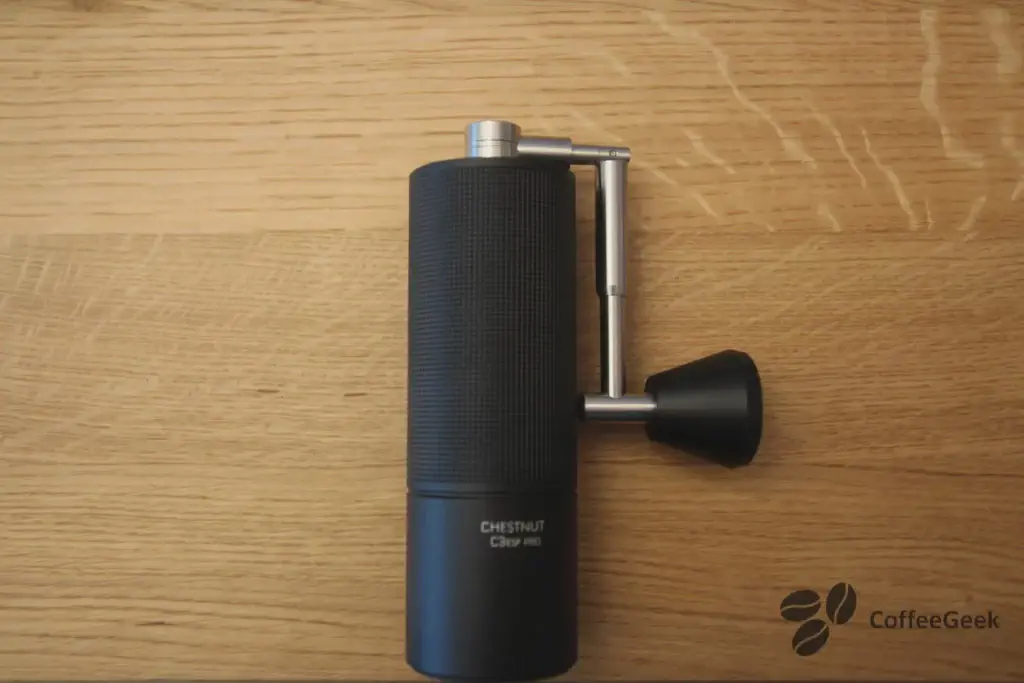
The crank is entirely made of metal (stainless steel) and integral with the aluminum cap. Despite its small size, the handle of the Timemore C3 ESP Pro affiliate linkoffers excellent grip and is equipped with a ball bearing, unlike the clip system used by competing brands such as 1Zpresso, Kingrinder or El Comandante C40. This ensures, in addition to exemplary build quality, that the handle does not accidentally detach from the crank.
When the crank is folded, a rubber stopper prevents the metal part of the crank from coming into contact with the grinder body.
Handle Attachment and Grinder Body
Another important aspect to highlight about Timemore grinders is the handle attachment with a ball bearing. This ensures smooth rotation of the handle and prevents it from being removed by simply pulling on it. Unlike other competing brands that use a clip system, the attachment here is much more solid. In the case of a clip attachment, there is an increased risk of the handle detaching, and some users have had to contact customer service for this issue. An excellent point therefore for Timemore.
The grinder body
The grinder body is entirely made of aluminum. Unlike other brands that opt for a completely smooth body, requiring a rubber ring to improve grip and prevent the grinder from slipping, Timemore has chosen a grooved surface. Personally, I find the grip very comfortable, and during use, the grinder doesn’t rotate on itself thanks to this design, despite the torque generated by the grinding effort.
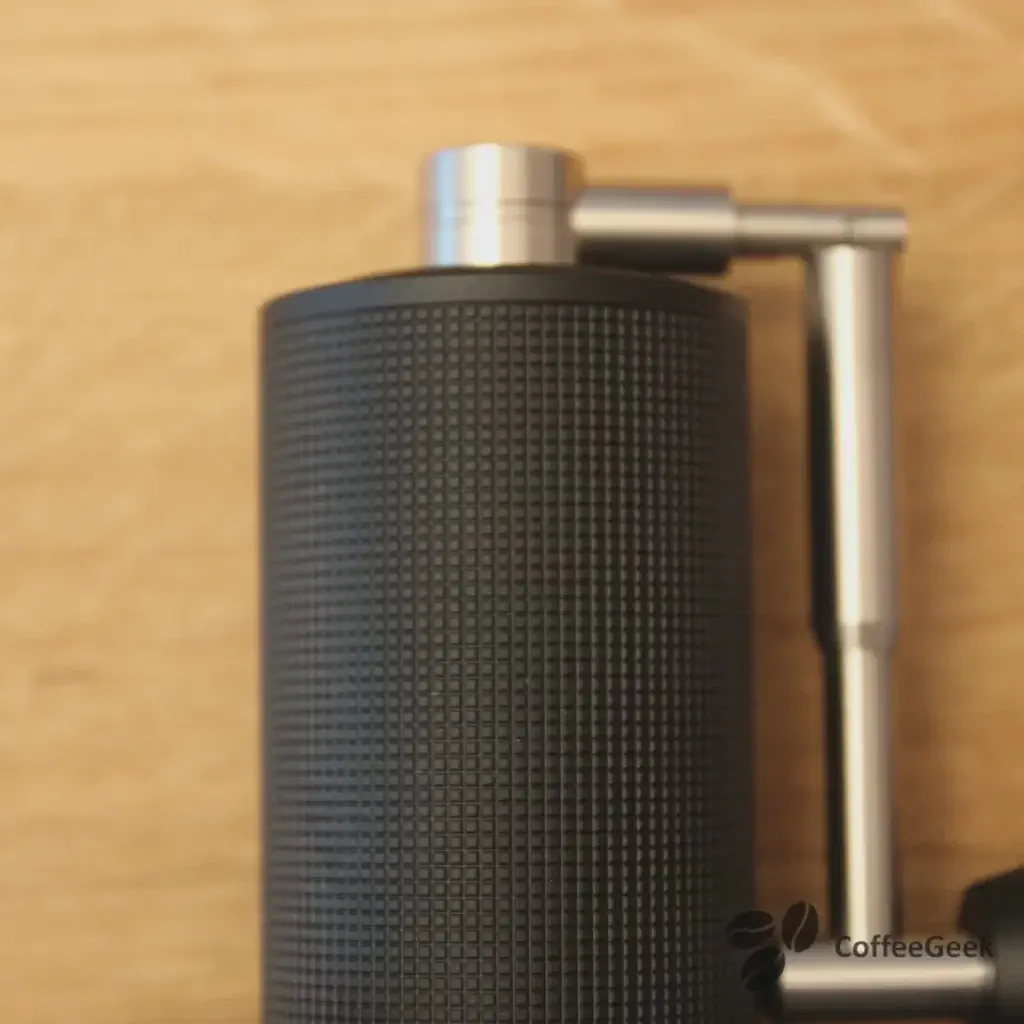
The adjustment dial
Unlike its big brother, the Timemore S3, the adjustment dial of the C3 ESP Pro model is located directly at the burr level.
While the Timemore C3/C3S models offer 12 clicks per rotation, the C3 ESP offers 30, similar to a grinder equipped with the “Red Clix” kit from the C40, which increases the number of available clicks.
The Timemore C3 ESP allows a 23.3 µm spacing per click.
Here are the recommended settings according to the extraction type:
The adjustment position is read as follows: the first number indicates the number of complete turns to make with the adjustment dial, while the second number specifies which graduation mark to stop at after completing the full turns. For example, a setting of 1.6 means you need to make one complete turn with the dial, then stop at graduation mark 6.
- Espresso: graduation 0.3 to 1.0
- Moka Pot: graduation 1.0 to 1.7
- AeroPress: graduation 9 to 25
- Pour Over: graduation 1.1 to 2.4
- French Press: graduation 1.9 to 2.5
The S2C600 burr
The S2C600 burr from Timemore is a derivative of the C2C800, previously used in the Timemore Chestnut X grinder, now discontinued. This new generation, the S2C600, equips several grinders in the Timemore range, such as the Timemore S3 that I tested a few months ago.
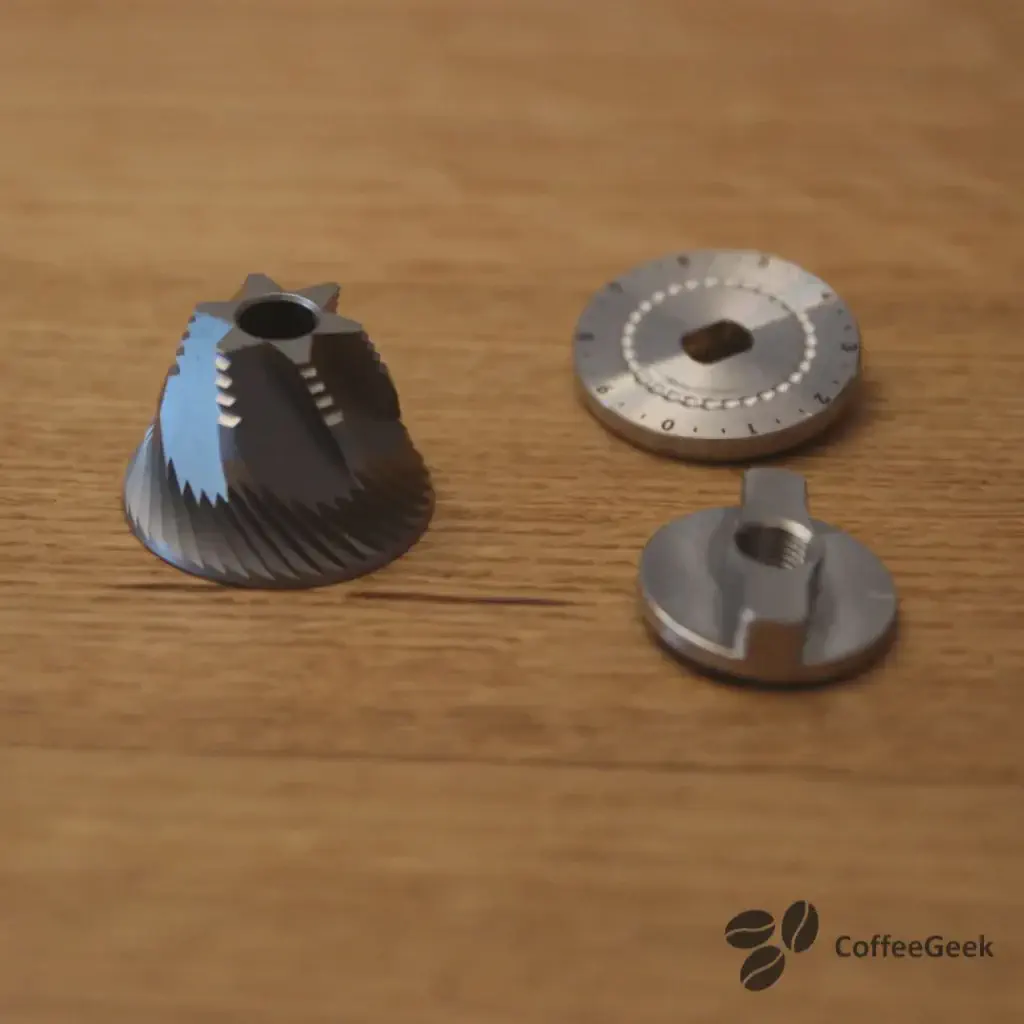
The Chestnut X burr had already impressed me with its ability to produce a consistent grind. Timemore has made some improvements, making the grind even more uniform with this new version.
The container
In my experience, the quality of the container often reflects that of the overall design and manufacturing of a grinder. For example, the Kinu Phoenix has a plastic container that is too light, which unbalances the grinder when placed on a countertop. The C40, on the other hand, has a lip inside its container, resulting in coffee retention when pouring it into the filter.
Regarding the Timemore, the container has no internal lip that could cause coffee retention. Moreover, its weight is sufficient to stabilize the grinder by lowering its center of gravity. Unlike other models such as those from 1Zpresso, the container attachment is done by screwing it on, which adds to its robustness.
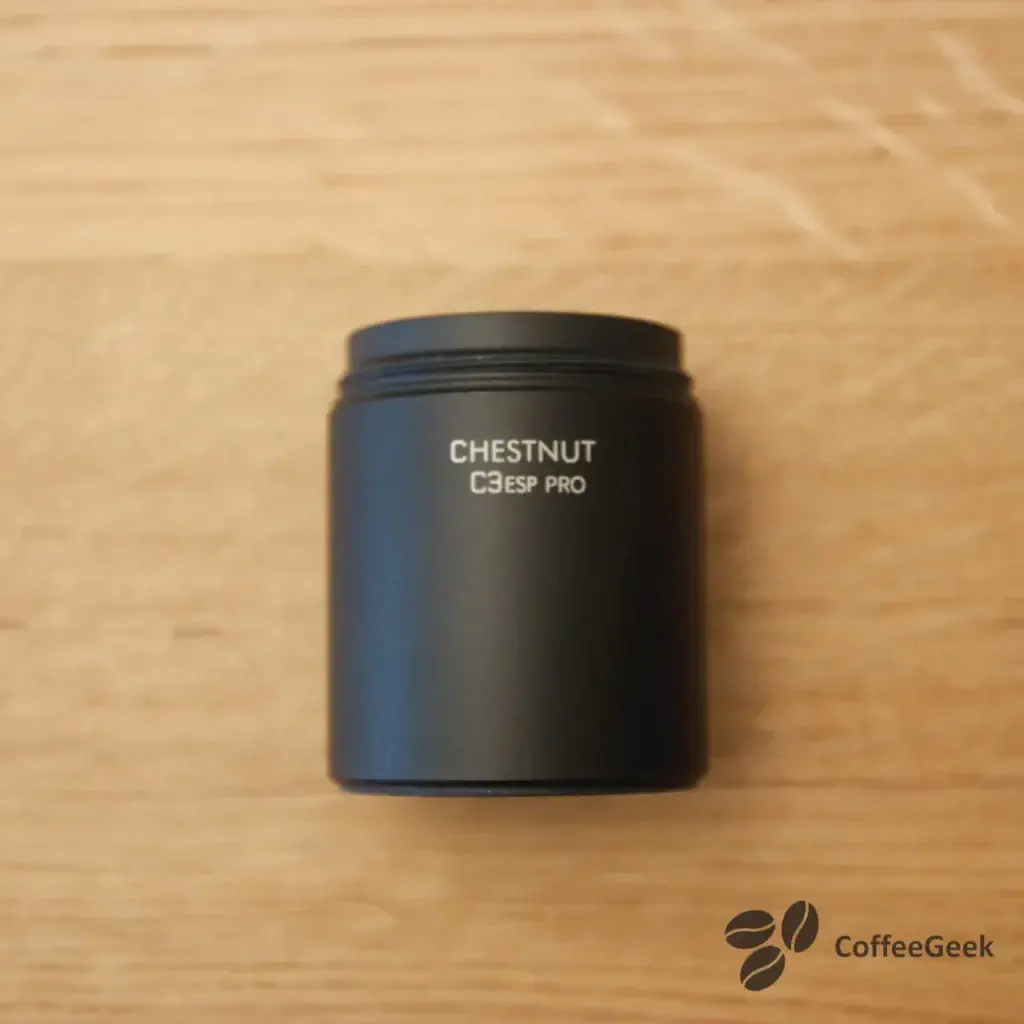
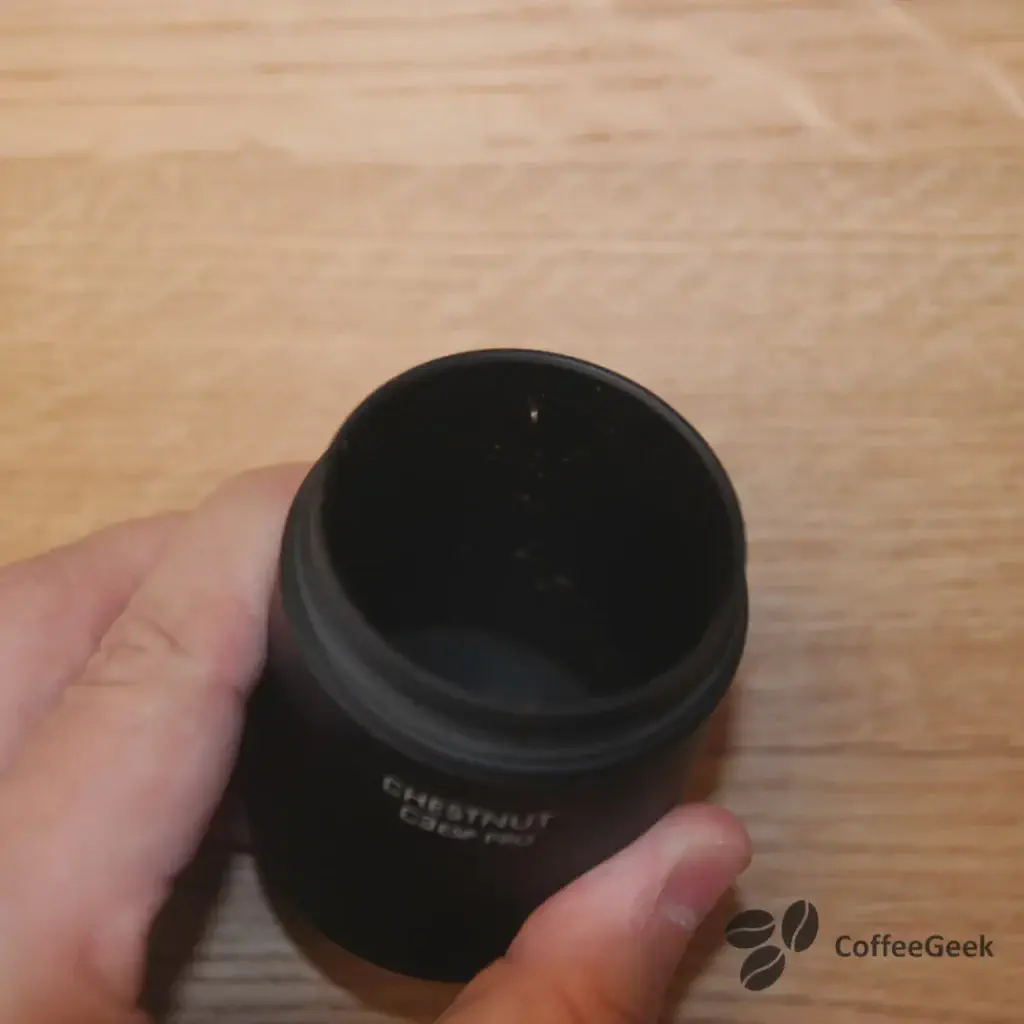
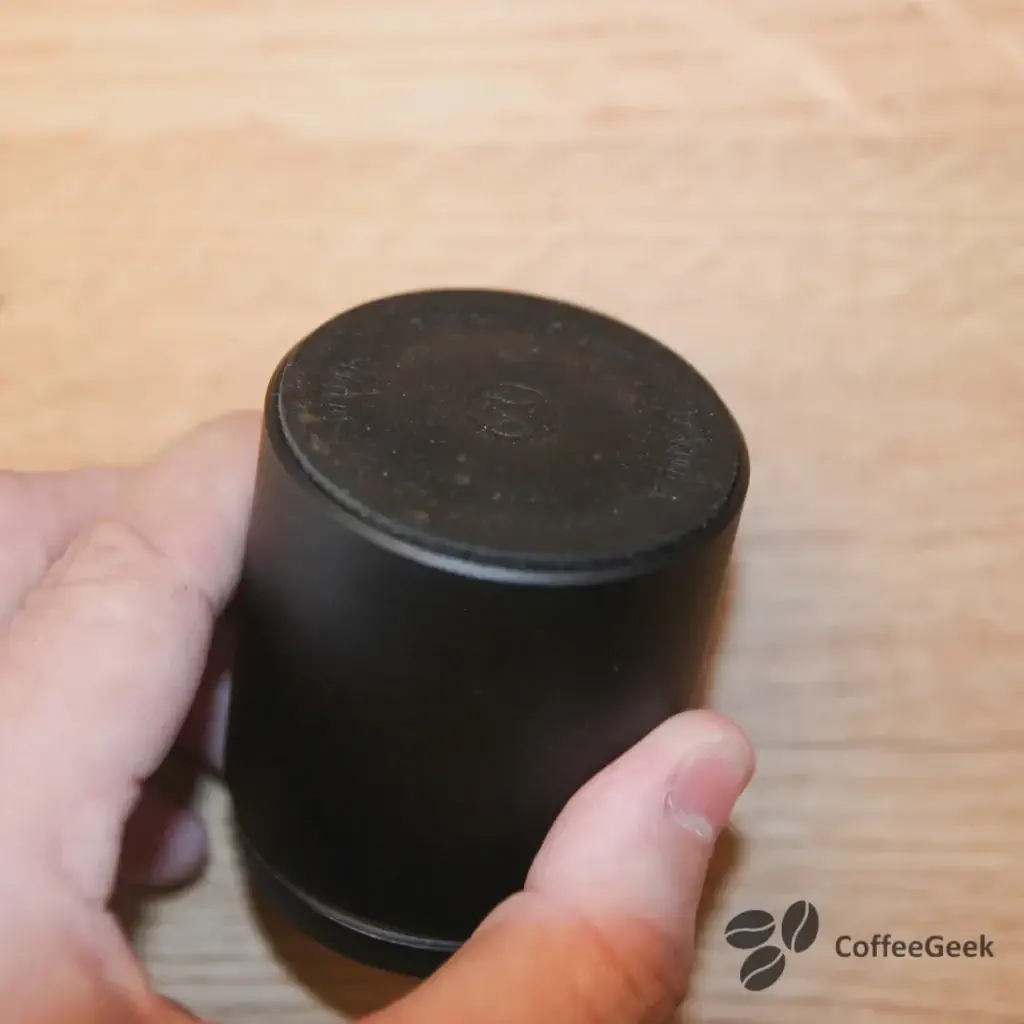
Finally, rubber has been placed under the container to protect the countertop, an appreciable detail that demonstrates the attention paid to the design.
Extracting an espresso with the Timemore C3 ESP Pro
Unlike the Timemore S3, which strongly disappointed me for espresso, the Timemore C3 ESP Pro allows you to make quality espresso. Here’s an example with a La Pavoni machine.
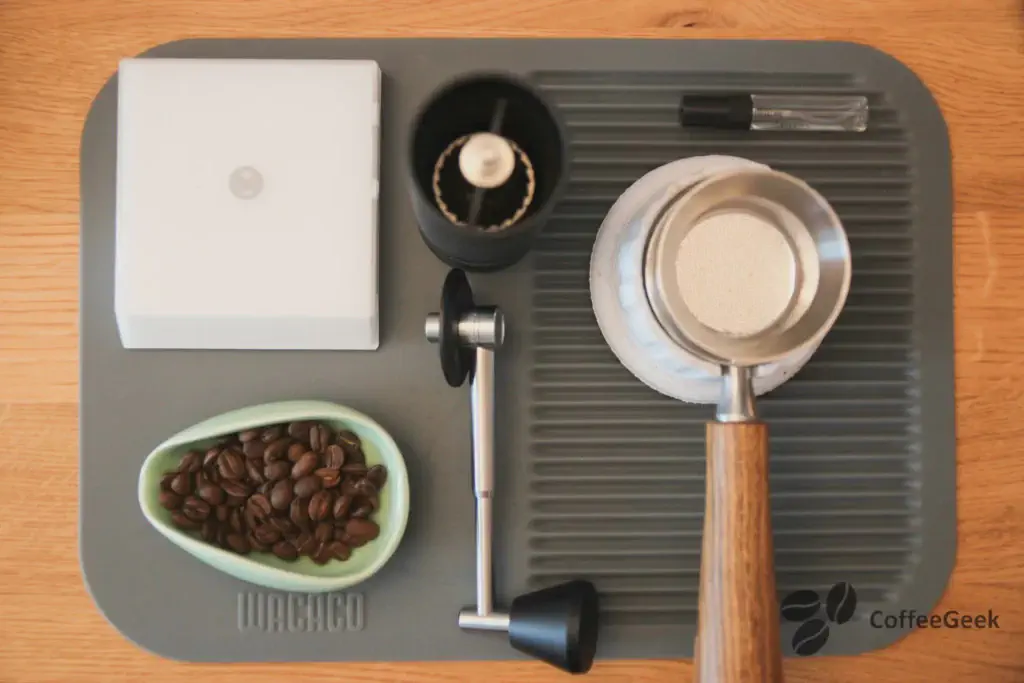
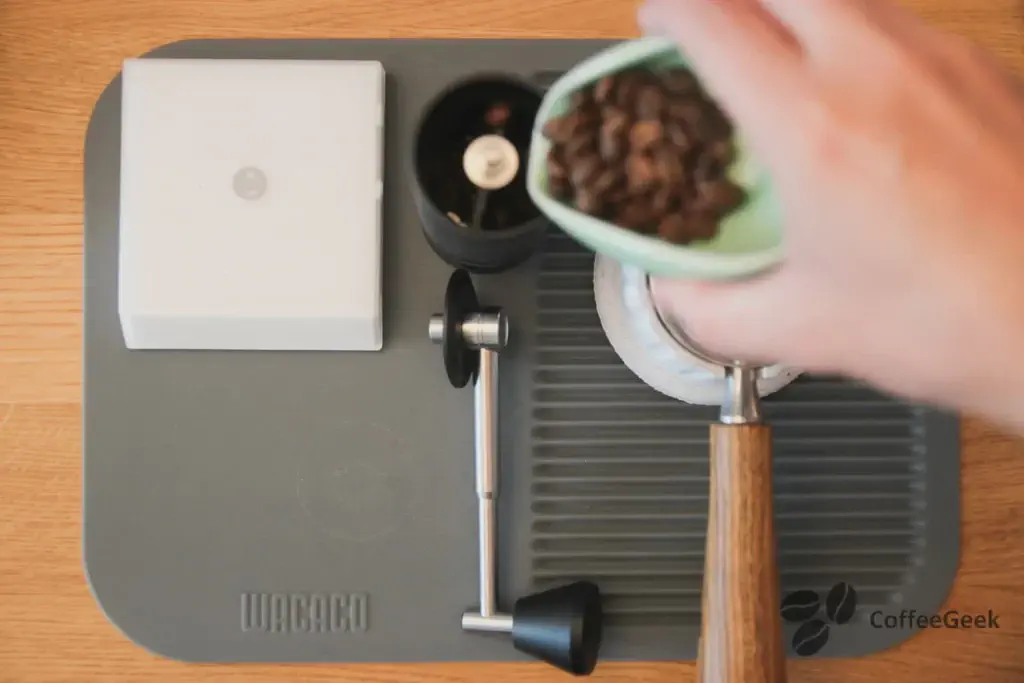
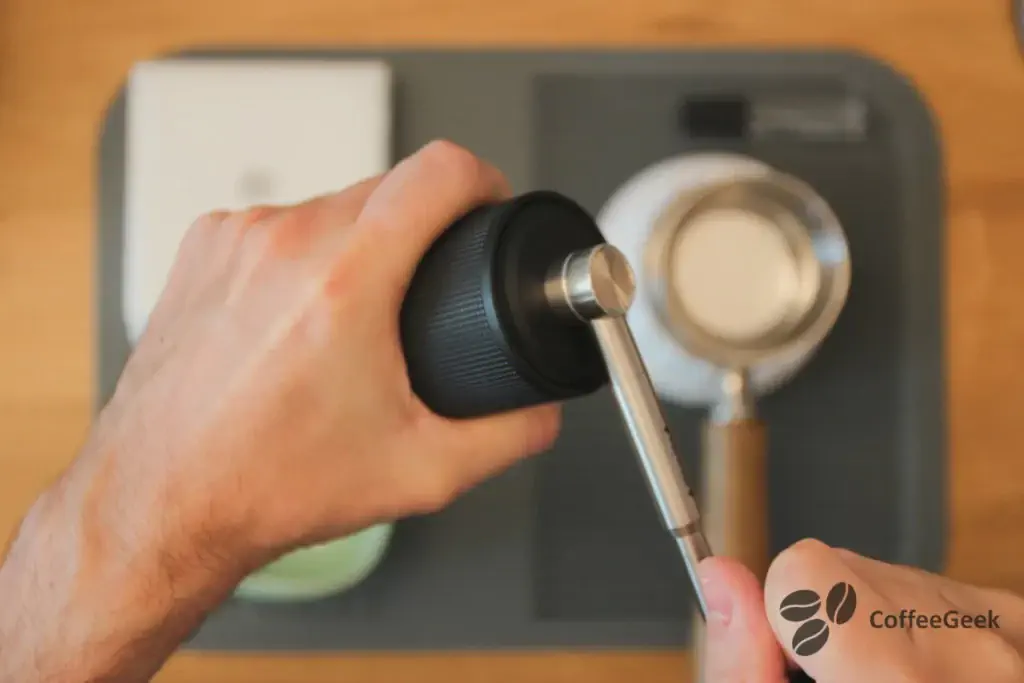
I weigh 16 g of coffee, spray a bit of water (RDT technique to reduce retention due to static electricity), then I grind it with the Timemore grinder.
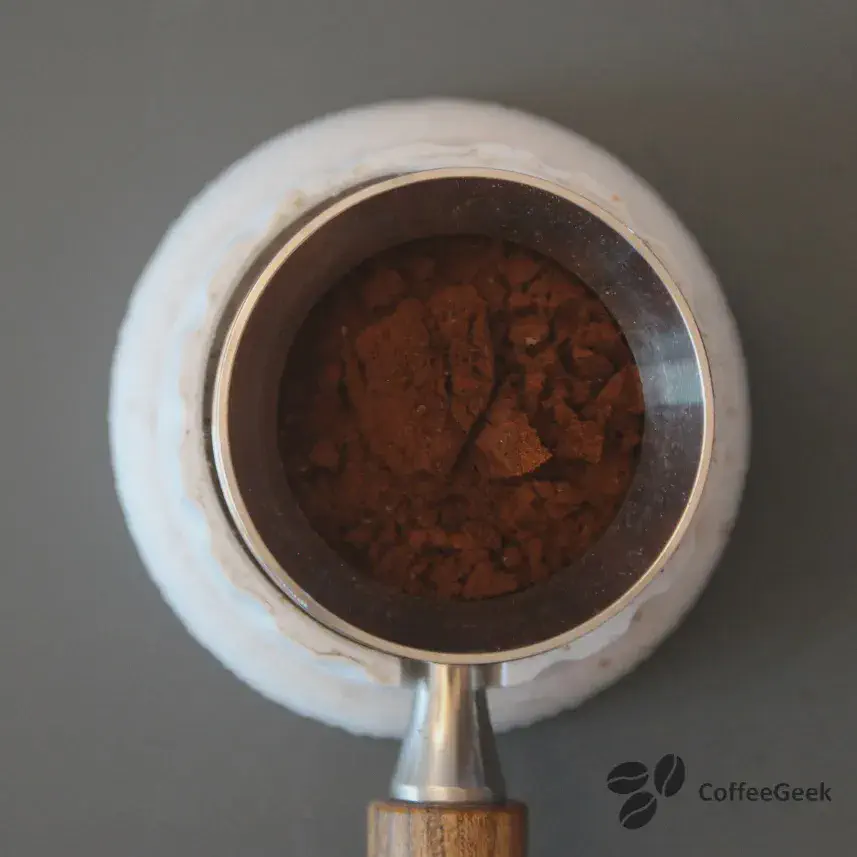
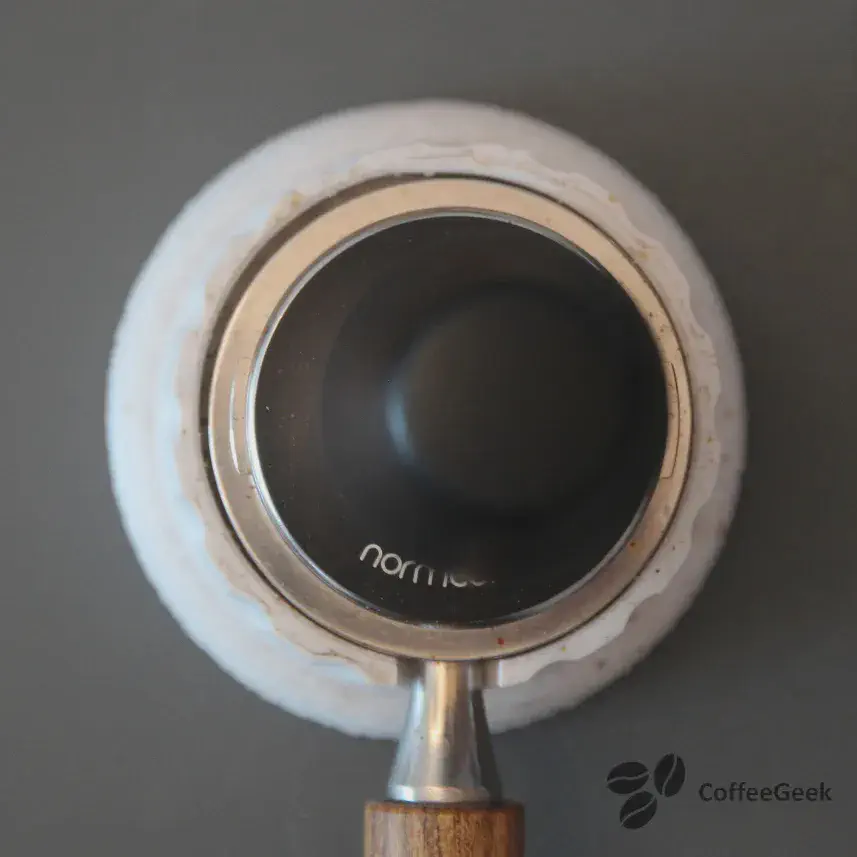
Coffee ground using the grinder with an espresso grind. Setting used: 0.50 (graduation 5 starting from 0, without a complete turn beforehand).
To avoid channeling, I break up the clumps and distribute the coffee evenly using my WDT affiliate link.
Finally, I place a puck screen and perform the extraction.
However, even though it’s possible to make espressos with this grinder, the Timemore C3 ESP Pro is not my first choice for this extraction. The main reason is the burr size, 38 mm, which significantly extends the grinding time compared to grinders equipped with larger burrs, such as the Kingrinder K6 or the more expensive 1Zpresso J-Ultra. Find a Timemore C3 ESP Pro coffee grinder on Amazon affiliate link
With the Timemore C3 ESP Pro, it takes me more than a minute to grind an espresso, whereas with 47 or 48 mm burrs, the time is reduced to about 40 seconds.
The Excellence of the Timemore C3 ESP Pro for Travel
For me, Timemore has always excelled in extractions requiring a coarser grind, unlike competing brands such as 1Zpresso, which I find more specialized in espresso.
I can guarantee you that the grind obtained with the Timemore is truly consistent, demonstrating the brand’s expertise. Whether for a V60 or with my travel machine: the Pipamoka affiliate link(the reason I bought this grinder), it’s the perfect compromise for me.
The 38 mm burr poses no problem for this type of extraction, as the grinder quickly grinds a coarse grind.
Preparing coffee with the Wacaco Pipamoka
These simple steps allow you to quickly prepare quality coffee, even on the go.
- Grind 14 g of coffee with the Timemore C3 ESP Pro: I use the 1.9 setting (one full turn of the adjustment dial, then to position 9).
- Pour the ground coffee into the capsule using the small funnel provided to avoid spilling it.
- Roughly distribute the coffee in the capsule before closing it.
- Close the capsule using its lid.
- Fill the reservoir with hot water.
- Insert the capsule into the Pipamoka and wait approximately 30 seconds until there are no more air bubbles.
- When the air bubbles have disappeared, close the Pipamoka with the lid.
- Turn the base of the Pipamoka to create extraction pressure.
- And here’s the result:
Enjoy your coffee freshly brewed.
Disassemble and clean the Timemore C3 ESP Pro
To reassemble and clean the grinder, it’s very simple. Here are the detailed steps:
- Fully unscrew the adjustment knob to release the burr.
- Remove the central shaft, which allows access to the inside of the grinder.
- Clean the inside of the grinder with a brush or dry cloth to remove coffee residue.
- Reassemble the grinder in reverse order: replace the central shaft, reinstall the burr, then screw the adjustment knob back on.
These steps ensure easy and quick maintenance of the grinder, thus guaranteeing its durability and performance.
Conclusion
I acquired this coffee grinder primarily for my travels, and I mainly use it with my small travel coffee machine, the Wacaco Pipamoka. The Timemore C3 ESP Pro affiliate linkwon me over with its small size, its attractive price, its build quality, and the consistency of its grind.
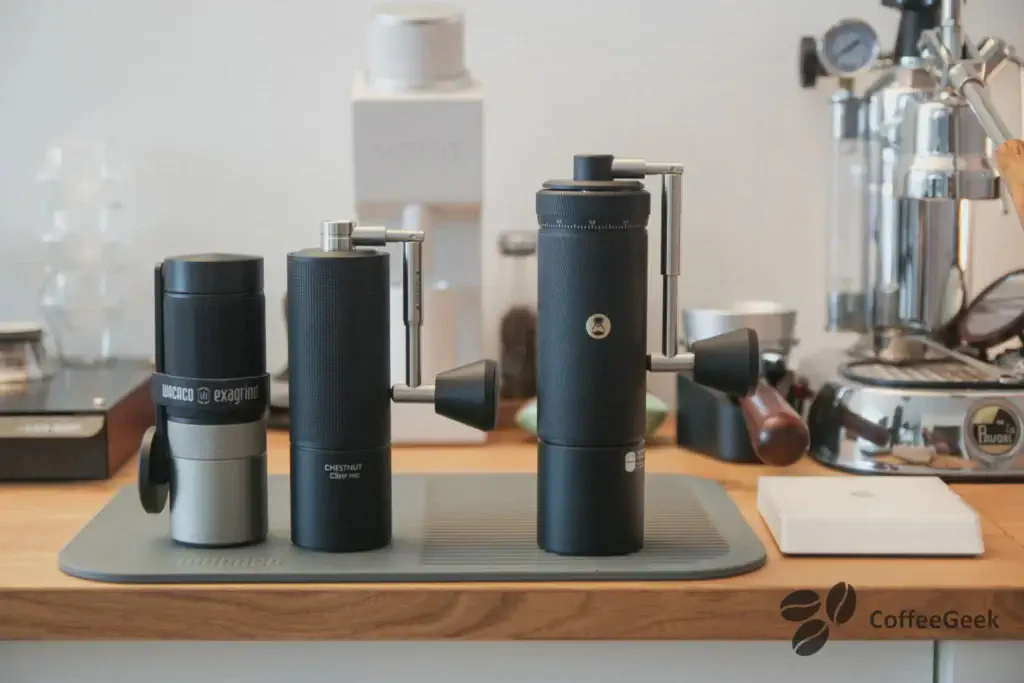
From left to right: the Wacaco Exagrinder affiliate link, the Timemore C3 ESP Pro, the Timemore S3.
I find it particularly suited to filter coffee due to its small burr. That said, it is quite capable of producing espressos, although it takes a bit more time to grind the coffee.
To compare Timemore grinders, I definitely prefer the C3 ESP Pro over the S3. The S3 is bulkier, has a larger burr, but it is not suitable for making espressos, unlike the C3 ESP Pro. If you’re looking for an even more compact grinder, I invite you to read my review of the Wacaco Exagrinder, designed specifically for this purpose.
Find a Timemore C3 ESP Pro coffee grinder on Amazon affiliate linkTherefore, I give it a rating of 5 stars.
Therefore, I give it a rating of 5 stars.
★★★★★
- Affordable price
- Excellent value for money
- Build quality and materials used
- Quality and consistency of the grind
- Extremely low retention
- Easy and pleasant handling
- Build quality
- Extremely low retention
- Folding handle (pro version)
- Long grinding time for an espresso
